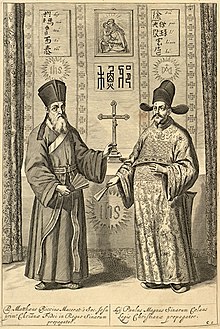
Back الرومانية الكاثوليكية في الصين Arabic Çində roman katolisizm Azerbaijani Katolická církev v Číně Czech Römisch-katholische Kirche in China German Iglesia católica en China Spanish Église catholique en Chine French Gereja Katolik di Tiongkok ID Chiesa cattolica in Cina Italian 중국의 로마 가톨릭교회 Korean Katholicisme in China Dutch

| Part of a series on the |
| Catholic Church by country |
|---|
 |
|
|
The Catholic Church (Chinese: 天主教; pinyin: Tiānzhǔ jiào; lit. 'Religion of the Lord of Heaven', after the Chinese term for the Christian God) first appeared in China upon the arrival of John of Montecorvino in China proper during the Yuan dynasty; he was the first Catholic missionary in the country, and would become the first bishop of Khanbaliq (1271–1368).[1]
After the Chinese Communist Party (CCP) won the Chinese Civil War, Catholic and Protestant missionaries were expelled from the country. In 1957, the communist government established the Chinese Catholic Patriotic Association (CCPA) in Beijing,[2] which rejects the authority of the Holy See and appoints its own preferential bishops. In September 2018, China and the Holy See reached a provisional agreement giving the Pope the power to veto any bishop which the Chinese government recommends. The parties have extended the provisional agreement twice, most recently in October 2024.
- ^ "Giovanni da Montecorvino: Franciscan missionary". Encyclopædia Britannica. 2022. Retrieved 21 August 2022.
- ^ Tang, Edmond; Weist, Jean-Paul (17 May 2013). The Catholic Church in Modern China: Perspectives. Wipf and Stock. pp. 13ff. ISBN 978-1-625-64086-4.